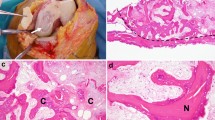Abstract
An osteochondral lesion in a weight bearing joint causes therapeutic problems. Surgical therapy focuses on the restoration of the articular surface, unlimited motion of the joint and prevention of cartilaginous degeneration. A causal therapy to prevent posttraumatic osteoarthritis is the fixation of osteochondral fragments. Various absorbable implants for the purpose of refixation are available, but only a few have proved to be biocompatible.
This retrospective study presents the preliminary results after refixation of osteochondral fragments of the ankle and knee joints. We used self-reinforced absorbable pins, nails and screws made of polylactide acid. The results for 15 patients with 17 fractures of 16 joints were evaluated. All patients were scored by the Tegner-activity-level, the McDermott-score and the DGKKT-score, and 13 of them were monitored by postoperative magnetic resonance imaging (MRI). The follow-up extended for an average of 14.3 months (range: 4-43 months). The clinical results for all patients were good (McDermott-score: Ø 89 points, DGKKT-score: Ø 78.8 points, Tegner: pre-op vs post-op=Ø 4.6 vs Ø 5.1) and the surgical therapy proved to be successful. The MRI showed the complete incorporation and vitality of the fragment as well as a congruence of the joint surface. The clinical course and the MRI gave little reference to an inflammatory reaction due to the implants that complicated the course of two patients. These results indicate that absorbable implants made of polylactide acid are biocompatible and effective in the fixation of osteochondral fragments.
Zusammenfassung
Ein osteochondraler Schaden in der Belastungszone eines Gelenkes ist weiterhin ein therapeutisches Problem. Das Ziel der Therapie ist die Wiederherstellung der Knorpeloberfläche mit normaler Gelenkfunktion, freier schmerzloser Beweglichkeit und Verhinderung einer weiteren Knorpeldegeneration. Dies lässt sich vielfach dadurch erreichen, dass osteochondrale Fragmente refixiert werden. Hierfür stehen resorbierbare Implantate aus verschiedenen Materialien zur Verfügung, die jedoch nicht alle gut biokompatibel sind.
In der vorliegenden Arbeit werden die kurz- und mittelfristigen Ergebnisse einer retrospektiven Studie nach Fixation osteochondraler Frakturen traumatischer Genese an Knie- und Sprunggelenk dargestellt. Verwendet wurden Stifte, Nägel und Minischrauben aus “selbstverstärktem” Polylaktid. Fünfzehn Patienten mit 17 Frakturen an 16 Gelenken konnten wir nachuntersuchen und einer Scorebeurteilung unterziehen. Bei 13 Patienten erfolgte ergänzend eine Magnetresonnanztomographie. Die klinischen Ergebnisse im McDermott-Score (Ø 89 Pkt.), DGKKT-Score (Ø 78,8) und Tegner-Aktivitätsscore (Ø 4,6 vs. 5,1) waren bei einem durchschnittlichen Follow-up von 14,3 Monaten (4–43) gut, bestätigt durch eine vollständige Integration des vitalen Fragmentes mit Wiederherstellung der Oberflächenkongruenz in der MRT. Weder klinisch noch kernspintomographisch fanden sich ossär, extraartikulär und intraartikulär/synovial Hinweise auf lokale Fremdkörperreaktionen. Lediglich bei 2 Kniegelenken zeigte sich ein gering bis mäßig ausgeprägter Gelenkerguss bei den spät resorbierbaren Implantaten. Unseren Ergebnissen zufolge sind die verwendeten Implantate aus Polylaktid biokompatibel und effektiv für die Refixation osteochondraler Fragmente.
Similar content being viewed by others

Author information
Authors and Affiliations
Corresponding author
Rights and permissions
About this article
Cite this article
Fuchs, M., Vosshenrich, R., Dumont, C. et al. Refixation osteochondraler Fragmente mit resorbierbaren Implantaten. Chirurg 74, 554–561 (2003). https://doi.org/10.1007/s00104-003-0623-9
Issue Date:
DOI: https://doi.org/10.1007/s00104-003-0623-9



